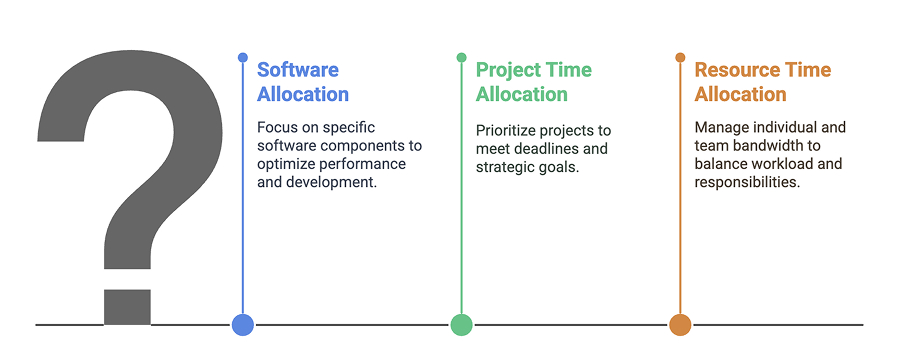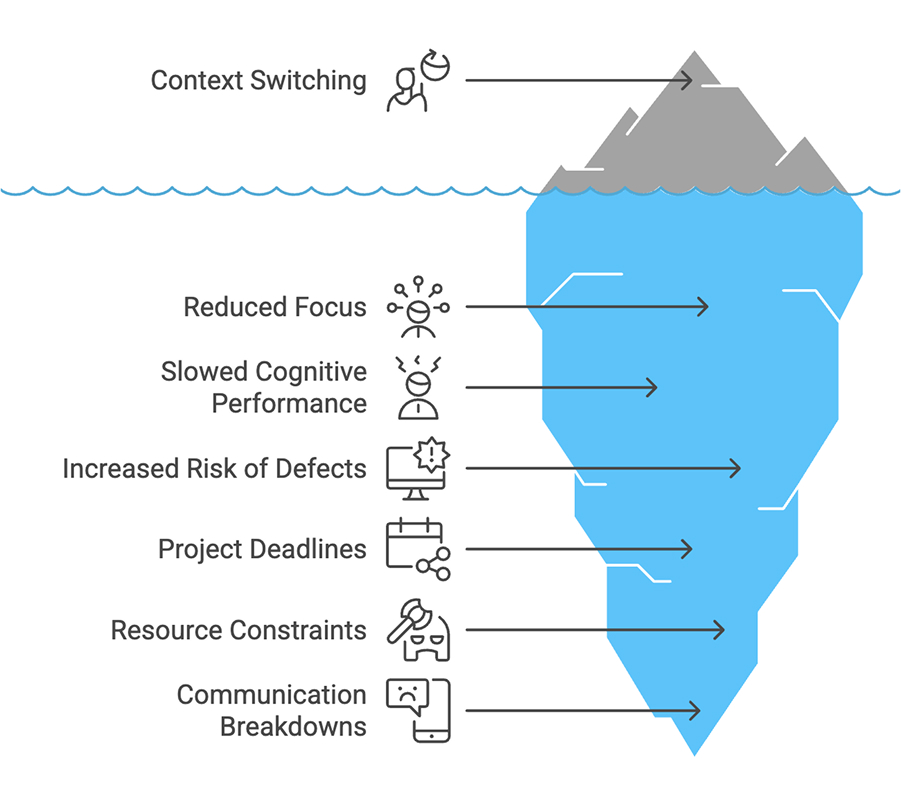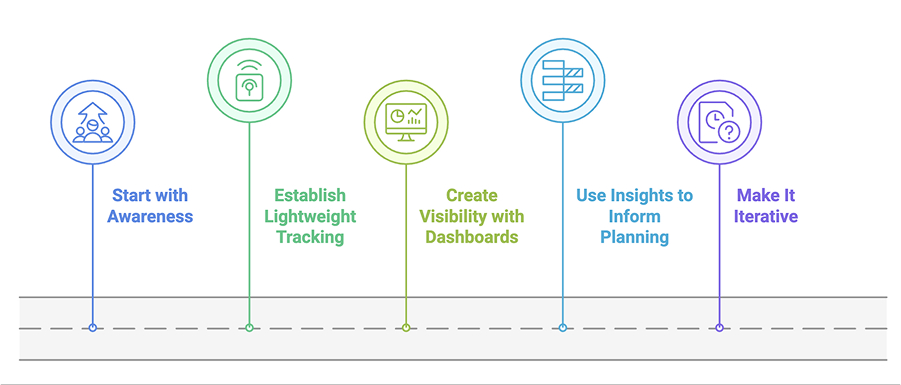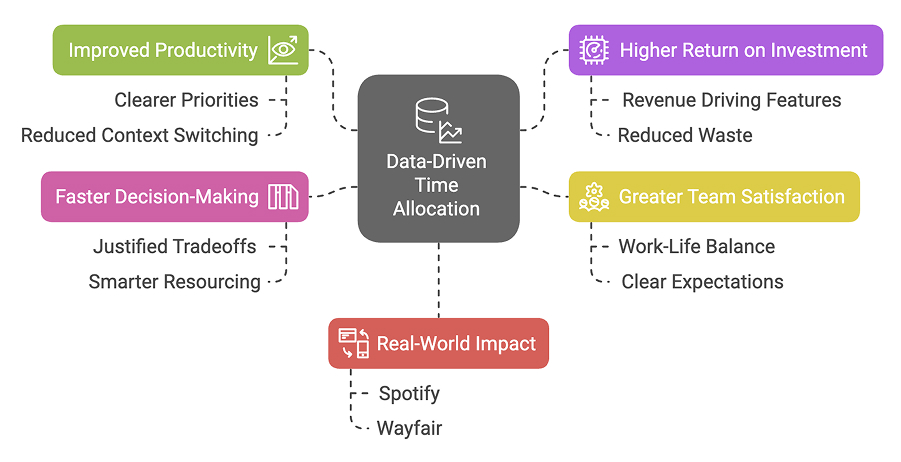Time is one of the most important resources in any engineering team. But without clear planning and visibility, it’s easy for that time to get lost in meetings or low-impact tasks that don’t move the team forward.
Time allocation is about making smart decisions on where engineering effort goes. It helps teams stay focused, avoid burnout, and make steady progress on the right priorities.
In this article, we’ll look at how using data-driven strategies can improve how teams manage their time. With better insights into where time is spent and where it should be spent, team leads or managers can plan more effectively, balance workloads, and improve overall performance.
What is Time Allocation in Engineering?
Time allocation in engineering refers to how a team’s working hours are distributed across different types of work, like building new features, fixing bugs, maintaining systems, or planning future projects. It helps answer questions like:
- Are we spending too much time on maintenance?
- Do we have enough capacity for new development?
- Are certain team members overloaded while others are underused?

There are three key dimensions to consider:
- Software allocation: How engineering effort is divided across the software stack, such as backend, frontend, infrastructure, or data systems.
- Project time allocation: How much time goes into specific initiatives, whether it’s a product launch, internal tooling, or a compliance update.
- Resource time allocation: How individual and team bandwidth is managed across all responsibilities, including unplanned work and on-call duties.
When these areas are tracked and balanced effectively, teams can make better decisions and plan more accurately to align with company goals.
Key Challenges in Engineering Time Allocation
Even experienced engineering teams struggle with time allocation. Without planning, time naturally drifts toward urgent work, ad hoc requests, and inefficiencies.
1. Unbalanced Workloads
Some engineers seem to work on the more intricate or high-priority work, while others pick up the more routine but core components. This shift in focus often goes unnoticed until it impacts delivery deadlines or team morale.
Consider a scenario where a developer is constantly tagged with customer-facing bugs. They will sometimes get trapped in a reactive cycle and will be unable to participate in long-term strategic work, which can result in burnout.
2. Lack of Visibility
Without reliable data, leaders must rely on unreliable feedback or personal observations. Engineers might say they’re spending most of their time on roadmap features, but ticket history could show the majority of their capacity goes to support or platform stability.
Lack of visibility also prevents proactive interventions. When time misallocation becomes obvious, critical deadlines may already be missed.
3. Context Switching

Shifting tasks is a daily routine for many engineers as they juggle different projects, environments, or responsibilities multiple times a day. This may lead to division of attention, hinder cognitive functioning, and increase the potential for errors.
When engineers are forced to split attention across roadmap features, legacy maintenance, and stakeholder escalations, they lose the concentration required for deep thinking and efficient execution.
4. Unclear Priorities
Even with a clear roadmap, shifting stakeholder demands, urgent issues, or lack of coordination can obscure what’s most important. In this environment, time often flows toward whoever shouts loudest, not necessarily what drives the most value.
This challenge is especially common in cross-functional teams where product, support, and operations pull on engineering time. Without clear guardrails, the team ends up reactive and misaligned.
5. Overweight Maintenance or KTLO (Keep the Lights On)
Maintenance work is essential, but it shouldn’t dominate an engineering team’s time budget. Yet, in many organizations, engineers spend a surprising amount of their week firefighting infrastructure issues, patching bugs, or manually resolving edge cases.
The danger is that KTLO work tends to expand quietly. If not measured and capped, it can crowd out innovation, delaying feature delivery and slowing down the entire organization.
How to Introduce Time Allocation Practices in Your Team

Improving time allocation isn’t just about deploying new tools; it requires a cultural and operational shift. Teams need to treat time as a measurable, valuable asset. The goal is to create transparency without adding friction or micromanagement.
1. Start with Awareness
Begin by initiating conversations with your team about how time is currently used. Use retrospectives, sprint reviews, or one-on-ones to ask:
- What types of work are taking more time than expected?
- Are there consistent interruptions or recurring tasks that go unplanned?
- Are we spending enough time on innovation, or are we mostly reacting?
This step builds psychological safety and starts aligning everyone around the value of intentional time allocation.
2. Establish Lightweight Tracking
Don’t introduce full-blown time sheets. Instead, embed tracking into the team’s existing tools:
- Tag stories or tasks in Jira or Linear with categories like feature work, tech debt, support, or KTLO.
- For GitHub/GitLab users, add labels to PRs or branches based on work type.
- Encourage consistent categorization during sprint planning and grooming sessions.
This creates an unobtrusive way to collect meaningful data without overwhelming the team.
3. Create Visibility with Dashboards
Once data is flowing, build simple, team-level dashboards to visualize time distribution across categories, epics, or team members. Use these insights to spot imbalances or trends, such as:
- Excessive time spent on unplanned work
- Inconsistent distribution of responsibilities across engineers
- Lack of engineering capacity for roadmap work
Start with team-wide visibility to encourage a sense of shared ownership before drilling into individual-level data, which can be sensitive.
4. Use Insights to Inform Planning
Don’t let data sit unused. Integrate it directly into sprint planning and quarterly reviews by:
- Adjusting commitments based on observed capacity, not assumptions.
- Discussing time allocation trade-offs openly. For example, “If we spend 30% on platform stability, what does that mean for roadmap delivery?”
- Involving product managers and stakeholders so they understand the real cost of shifts in scope or urgent asks.
5. Make It Iterative
Time allocation isn’t static. It should evolve with regular reviews. Treat these reviews as inputs into roadmap discussions, hiring plans, and team health check-ins.
- What categories are growing or shrinking?
- Are we spending time on what matters most?
- Do we need to rebalance priorities or redistribute the load?
Tools and Techniques for Time Allocation
Data-driven time allocation is only as effective as the tools supporting it. To gain visibility and take action, engineering teams need systems that can track, visualize, and report on how time is used.
1. Time-Tracking Tools
While not always popular, lightweight time tracking can reveal patterns in where effort is spent. Modern tools minimize friction by integrating directly into developer workflows.
Examples:
- Clockify, Harvest: General purpose time trackers with team-level reporting.
- Toggl Track: Useful for tagging work by project or category.
- Timely: AI-assisted tracking that logs activities automatically.
2. Project Management Platforms
Project boards provide a structured view of what the team is working on and what’s coming next. When used consistently, they help identify bottlenecks and estimate effort distribution.
Examples:
- Linear, Jira, Shortcut: Track tasks, story points, and sprint velocity
- Notion, Asana: Flexible for engineering and cross-functional teams
Look for platforms that allow custom tagging or integration with Git-based workflows.
3. Git and Code Analytics Tools
Repositories offer a wealth of insight into developer activity. Tools that analyze Git history help measure code contribution trends, context switching, and time-to-merge.
Examples:
- Uplevel, Waydev, Code Climate
- GitHub or GitLab built-in analytics
These tools help identify how much time is spent on feature work vs. reviewing pull requests, refactoring, or responding to issues.
4. Dashboards and Visualization
Once data is collected, visualizing it is key to interpretation and decision-making. Dashboards help track progress and uncover imbalances. You can automate dashboard updates and review them in engineering retros or planning meetings.
Examples:
Benefits of Data-Driven Time Allocation
When engineering teams use data to guide how time is spent, the results go beyond better planning.

1. Improved Productivity
With clearer priorities and reduced context switching, engineers can stay focused on high-impact work. Teams avoid overcommitment and make steady, predictable progress. For example:
-
- Fewer blockers from unclear ownership.
- Better coordination across projects.
- More consistent delivery velocity.
2. Higher Return on Engineering Investment
Engineering time is expensive. When aligned with business goals, time allocation helps ensure the team is working on what truly matters, like:
- Focused work on revenue-driving features.
- Reduced waste on low-priority tasks.
- Increased visibility into effort vs. value.
3. Greater Team Satisfaction and Retention
Overworked engineers burn out. Underused engineers become lazy. Balanced, transparent time allocation supports healthier team dynamics.
- Better work-life balance through load distribution.
- Clearer expectations and less firefighting.
- Opportunities to invest time in learning or innovation.
4. Faster, Data-Backed Decision-Making
With dashboards and analytics in place, engineering leaders no longer rely on guesswork. Time allocation becomes a conversation about evidence, not assumptions.
- Easier to justify tradeoffs to stakeholders.
- Smarter resourcing across teams or sprints.
- Timely adjustments based on performance trends.
5. Real-World Impact
Several engineering-driven companies have adopted data-backed time allocation frameworks to great effect:
- Spotify implemented time tracking across squads to balance innovation vs. maintenance efforts.
- Wayfair shifted from ad hoc prioritization to structured time allocation reviews every quarter, leading to better alignment and less churn.
Conclusion
Engineering time is a limited resource. But with the right strategy, it can be managed with clarity and precision. Data-driven time allocation allows teams to align effort with impact, reduce wasted cycles, and operate with greater focus.
By tracking how time is spent across software areas, projects, and individual contributors, engineering leaders can identify imbalances, prioritize effectively, and make smarter decisions. Tools like time trackers, Git analytics, and visual dashboards provide the foundation for these insights.
In an environment where demands are constant and priorities shift fast, reactive planning is no longer enough. Teams that adopt structured, data-informed approaches to time allocation are better equipped to deliver value, support team health, and achieve long-term goals.


